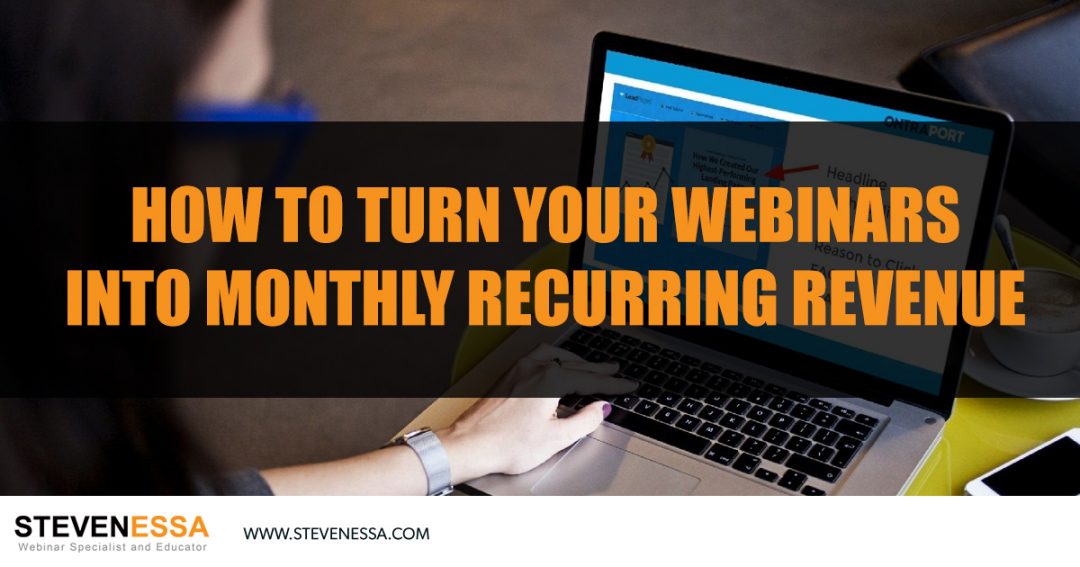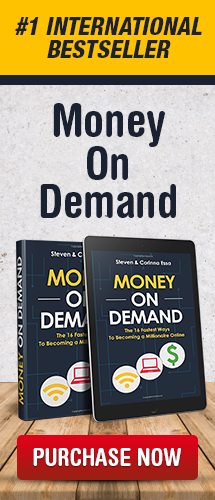Although webinars can bring a significant amount of money upfront (as much as $200,000 in 90 minutes has been reported) when using them to sell products, they can also enable you to generate significant recurring revenue.
By creating webinars without adding any selling element to them, these webinars can be recorded and stored on a paid membership site. This method allows anyone to generate recurring revenue without having to exchange time for money.
What is required:
- A WordPress site
- Hosting
- The ‘Wishlist’ WordPress plugin
- Recording and editing software (Camtasia or Screenflow)
- Payment processing facility (Paypal or online merchant account)
A membership site allows you to store unlimited videos, webinars and documents in a password-protected area on the web, only accessible by paid members.
Step 1: Create content-only webinars.
When putting this content together, structure is very important.
Content in a membership site should never be uncategorized, random information, scattered across the site. Your site should take your members through specific steps in a logical order. That way they feel like they’re making progress.
You should map out the content so that members are taken from point A (not knowing anything about the topic) to point B (having mastered the skill they were taught).
For example, let’s assume you wish to educate members on how to set up and run an eBook business and wish your members to stay subscribed for a minimum of six months. You could potentially structure your content in this way:
- PHASE 1: Market research
- PHASE 2: Writing your eBook
- PHASE 3: Paid traffic generation
- PHASE 4: Free traffic generation
- PHASE 5: Automation
- PHASE 6: Upsells
Each phase would then be broken into weeks (four weeks per phase). Each week could consist of one webinar, which is also broken down in steps as shown here:
- Webinar 1: Title
- Step 1
- Step 2
- Step 3
- Homework
- Resources
- Accompanying documents
By structuring your content this way, members are more likely to get faster results, and therefore remain loyal. In addition, having milestones increases the likelihood of members staying subscribed for the whole cycle.
Because people learn in different ways, including the same content in different formats can also set your membership site apart from others. For example, you can offer your content in .pdf format by simply transcribing your webinars, or in mp3 format, which allows people to listen to content while on the move.
Adding homework at the end of each lesson (webinar) also offers the opportunity for members to take action, remain engaged and assimilate the information. They implement each strategy and remain committed to the subscription.
Including a resource document, a frequently asked questions document, templates and checklists to accompany each webinar will also set your membership site apart.
Step 2: Once you have created pre-recorded content-only webinars, install the Wishlist plugin on your website.
The Wishlist plugin is easy to use and manage. It allows you to have unlimited membership levels, should you wish to provide different types of access for different customers.
For example, you can easily have three types of memberships like the ones below:
- Standard ($47 a month)
- Gold ($67 a month)
- Platinum ($97 a month)
In addition, the upgrade process is completely automated, because when members try to access content not included in their membership level, they see the message below:

Step 3: Set up a sales-processing facility.
To process sales for subscription-based products, merchant facilities such as paypal.com allow you to create recurring payment links.
PayPal also enables you to automate a big section of customer service. It allows you to send an email confirmation automatically. This would send your customers their membership access details upon completing their payment.
If you already have an online merchant facility, other services such as 1shoppingcart.com and infusionsoft.com also allow you to create recurring payment links and set up automated email confirmations.
Step 4: Price your membership.
For most membership sites, prices tend to remain below $100 a month. Although there is no specific rule when it comes to pricing, as it can fluctuate significantly according to the topic, the industry, the competition and the target audience, testing different prices is the best way to proceed.
At first, put your monthly fee at any price below $100, and as people start buying, closely monitor your conversion rate. If your conversion rate is below ten per cent, start putting the price down or add more value to make your offer even more irresistible. If your conversion rate is above ten per cent, increase the price until you hit a ten per cent conversion rate.
Once you’ve secured a few monthly paying subscribers, the key to your financial success will be to keep them subscribed for as long as possible. A lot of membership site owners will tell you that the average ‘stick rate’ is three months, which means that you’ll have to keep putting effort into acquiring new customers every three months.
Step 5: Promote your membership site.
The best way to cultivate interest for your membership site is to create teaser content and distribute it using different online channels such as:
- Blogs: Blog posts tend to attract an audience of people eager to learn more about a topic. Therefore, create a series of blog posts that include calls to action. Pointing your blog post to your webinar promoting your membership site will drive considerable amounts of free traffic.
- Webinars: A webinar is a great opportunity to showcase your membership site. You offer one hour of incredibly valuable information. Then you offer the option for people to further their education by joining your subscription-based content. It’s an easy way to turn webinar attendees into subscription-based customers.
- YouTube videos: Youtube.com has become the second most-visited website on the web. Create a YouTube channel to host teaser videos that also point to the sales video of your membership site. YouTube alone could generate a significant amount of free traffic.
- Social media: Two billion people are currently using one or more social platforms to connect and exchange information. Therefore, if you tap into this traffic source, chances are you’ll be able to reach potential customers.



Thank you Steven. This is fabulous information. I will add it to my To Do list and schedule it into my program. Great stuff.
Thanks great article. I’m still developing my funnel and this makes absolute sense to create a subscription product. Really appreciate your words of wisdom.
Great content Steve always valuable short and to the point
great article thanks.
……..Just above Step 3 title I think there are some missing words??????